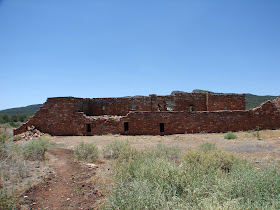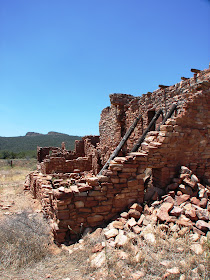Here is our second story of this series about a great Native American ruin, called Kinishba. An especially beautiful place to visit with the leaves of autumn or in late spring with all the beautiful wildflowers. And, just like Honanki, you can literally walk in and among these ruins. Hope you get to visit this wonderful Arizona treasure!
A short five miles from Fort Apache on the White Mountain Apache Indian Reservation near Whiteriver, Arizona stands the ruins of the ancient pueblo known as Kinishba. Kinishba receives its name from the Apache words “ki datbaa” which translate to mean “Brown House”. It is the ruins of a pre-Columbian Pueblo village that was occupied by the Mogollon People around 1250 to 1400 A.D.
The pueblo is located along a small arroyo at the far end of grass covered valley. It was a large pueblo, with 400 – 500 ground level rooms rising to two and three stories in height. At its apex, archeologist believe as many as 1000 Mogollon People occupied this beautiful White Mountain site.
Kinishba is the most publicly accessible of the 20+ large Mogollon Pueblo village ruins found in this part of Arizona. It was built as a part of the large Mogollon Rim colonization that occurred during this period of time.
Kinishba is located at an elevation of about 5000 feet, south of the Mogollon Rim, north of the Salt River and at the far eastern end of the Sawtooth Mountains. Here the people found land ideal for dry maize farming, a year-round source of water, and abundant sources of sandstone, limestone and ponderosa pine for pueblo construction.
The Mogollon People, like all things named Mogollon, are named after Juan Ignacio Mogollon, Spanish Governor of New Mexico from 1712 – 1715, were the third of the three major cultures that occupied the land that would become Arizona from 300 B.C. – 1450 A.D. In their heavily forested mountain highlands they created a culture based on dry, terrace farming, hunting and gathering.
It was the Mogollon People who first built the holy, underground chamber known as the kiva. They would share their concept of the kiva with the ancient Anasazi and thus it was passed on to the modern Hopi, Zuni and other Pueblo People of the Little Colorado and Rio Grande Rivers. It was from the sipapu of the Great Kiva that modern Pueblo People believe they emerged into this, the Fourth World.
A visitor to Kinishba today can peer into the ancient rooms that once held the community store of ancient corn and the living space of generations of Mogollon families. The village is made up of eight major mounds, rectangular in shape with large courtyards or plazas mixed among them.
The first major restoration of Kinishba occurred in the 1930s yet much work still needs to be done. It is one of too many historic places in Arizona waiting for appropriate funds to restore and preserve their story.
Archeological evidence from the Kinishba site indicate that both the Hopi and Zuni people occupied the ruins possibly as late as the early 19th Century. Archeologist in 1989 even went so far as to suggest that Kinishba just might be the fabled Chiciticale, made famous by the historic visit of Francisco Vasques de Coronado in May of 1540.
Permission to visit Kinishba ruins must be obtained from the Visitor Center located at Fort Apache. The entry fee for Fort Apache also allows one to visit the Brown House of the White Mountains – Kinishba!

























Very interesting and good pics...
ReplyDeleteNow I must go see for myself...
Thank you very much for sharing. ♡